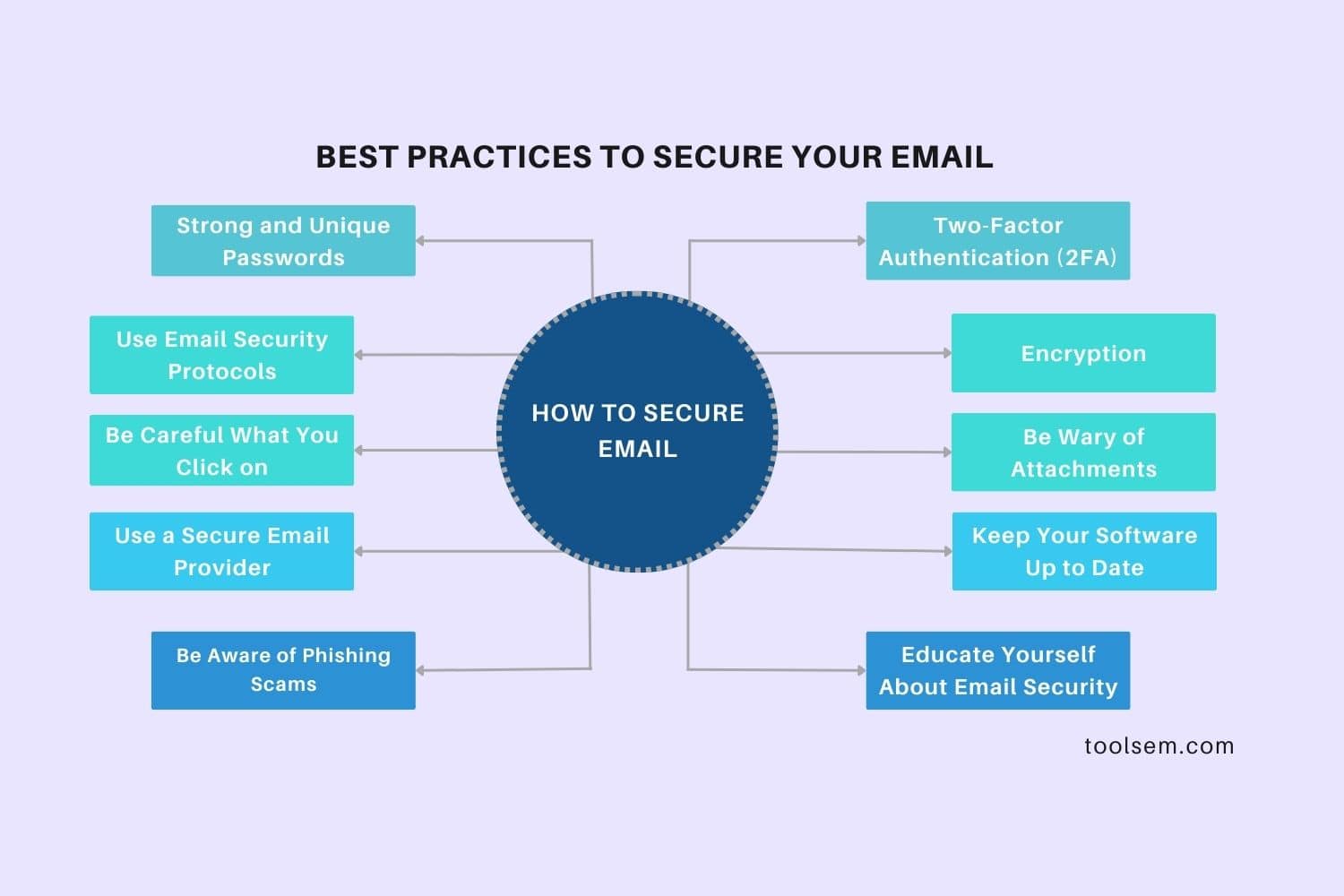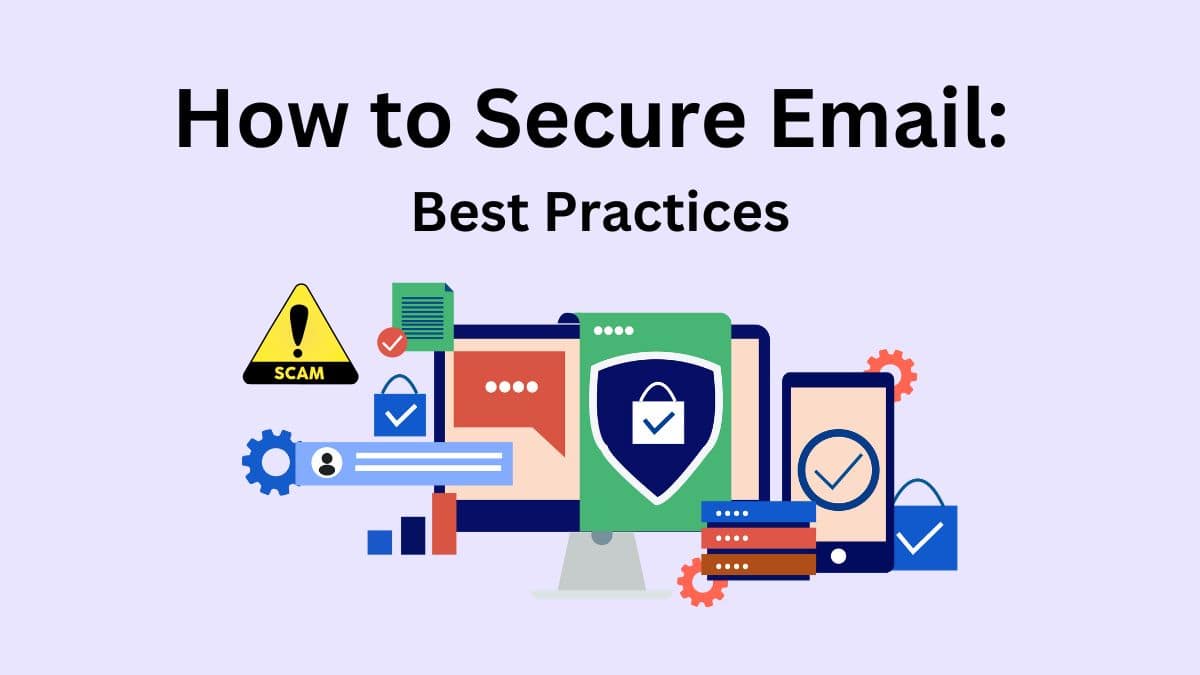Secure email is extremely important. With an increase in cyber threats and privacy concerns, it is essential to adopt best practices to secure our emails effectively.
Without a doubt, email is one of the most common ways we communicate today. But it is also one of the most vulnerable forms of communication. Emails can be intercepted, read, and even modified by hackers. That is why it is important to take steps to secure your email.
In this article, we will learn how to secure your email with these best practices and tips. But first, let’s look! What is secure email? Also, Why do we need email security?
The Best Practices to Secure Your Email:
- Strong and Unique Passwords
- Two-Factor Authentication (2FA)
- Use Email Security Protocols to Secure Your Email.
- Encryption
- Be Careful What You Click on.
- Be Wary of attachments.
- Use a Secure Email Provider.
- Keep Your Software Up to date.
- Be Aware of Phishing Scams.
What Is Secure Email?
Secure email is all about keeping your messages safe and private. It means using special techniques and tools to protect your emails from being read or accessed by people who shouldn’t see them. This is important because regular email sends messages in a way that anyone can read them. But with secure email, we add extra layers of security to make sure only the intended recipients can access the messages.
Why Do We Need Secure Email?
The reason we need secure email is because regular email is not very safe. When we send emails the usual way, they travel as plain text, which means they can be easily intercepted and read by others. This is a big problem when we want to keep our communications confidential. Secure email solutions come to the rescue by adding special features like encryption, authentication, and other security measures. These features make sure that our email messages stay private and secure from any unauthorized access or interception.

How to Secure Email: Best Practices
Let’s explore each one of the best practices to help you keep your email secure:
Strong and Unique Passwords
One of the fundamental aspects of securing your email is to use strong and unique passwords. Avoid common passwords such as “123456” or “password” that can be easily guessed. Your password should be at least 10 or 12 characters long and include a mix of upper and lowercase letters, numbers, and symbols.
Two-Factor Authentication (2FA)
Two-factor authentication is a security feature that adds an extra layer of protection to your email account. When you enable two-factor authentication, you’ll be required to enter a code from your phone in addition to your password when you sign in to your email account. By enabling 2FA, even if someone manages to obtain your password, they would still need physical access to your mobile device to gain entry.
Use Email Security Protocols to Secure Your Email
Spam filters use three key standards to identify and block unwanted emails: DKIM (DomainKeys Identified Mail), SPF (Sender Policy Framework), and DMARC (Domain-based Message Authentication, Reporting and Conformance. So long as you use these three standards together, spam filters can help to ensure that only legitimate emails reach your inbox.
Encryption
Email encryption ensures privacy and confidentiality by converting content into a deciphered code, preventing unauthorized access to sensitive information. PGP and S/MIME are two methods that can be used to protect your emails effectively. PGP stands for Pretty Good Privacy, and S/MIME stands for Secure/Multipurpose Internet Mail Extensions.
Be Careful What You Click on
If you receive an email from an unknown sender, it is best to err on the side of caution and avoid clicking on any links in the email. With this in mind, these links could be malicious and lead to websites that could infect your computer with malware.
Be Wary of Attachments
Don’t open attachments from people you don’t know. These attachments could contain malware that could infect your computer.
Use a Secure Email Provider.
There are a number of secure email providers available, such as ProtonMail, Hushmail and Tutanota. These providers use end-to-end encryption to protect your emails from being intercepted.
Keep Your Software Up to Date
Software updates are essential for keeping your computer safe from malware because they include security patches. So, make sure you keep your software up to date to get the latest security patches.
Be Aware of Phishing Scams
Phishing scams are emails that try to trick you into giving up your personal information. So, be careful about what information you give out in emails, and never click on links in phishing emails.
By following these best practices, you can help to secure your email communication and protect your personal and financial information.
Additional Tips for Securing Email
Here are some additional tips to secure your email:
- Use a spam filter.
A spam filter can help to reduce the amount of spam that you receive in your inbox. This will help to protect you from phishing emails, which are emails that try to trick you into revealing personal information.
- Be careful what you share in emails.
Don’t share sensitive information in emails, such as your social security number, credit card number, or bank account number. If you need to share this information, do it over a secure channel, such as a secure website or a phone call.
- Be aware of the risks of public Wi-Fi.
When you use public Wi-Fi, your emails are not as secure as they would be if you were using a secure connection, such as your home Wi-Fi. If you need to send or receive sensitive emails, it’s best to do it over a secure connection.
- Use a VPN.
A VPN can help to protect your privacy and security when you’re using public Wi-Fi. A VPN encrypts your traffic, so it can’t be intercepted by hackers.
- Be aware of the latest email scams.
Hackers are constantly coming up with new ways to scam people. Make sure you’re aware of the latest scams so you can avoid them.
Other Things You Can do to Secure Your Email
In addition to the above, here are some other things you can do to secure your email:
- Use a password manager.
Password managers are a valuable tool for anyone who uses the internet and can help you create and store strong passwords. This will make it easier to keep your passwords secure and prevent you from reusing passwords across different accounts.
- Regular backup
Regular email backups are crucial for data protection and business continuity. Utilize cloud storage services or dedicated solutions to automate the process and store securely.
- Be careful about what you post on social media.
What you post on social media can be used to target you with phishing emails. Be careful about what you share on social media, and don’t share any personal information that you wouldn’t want a hacker to know.
- Educate yourself about email security.
The more you know about email security, the better equipped you will be to protect yourself from hackers. There are a number of resources available online that can help you learn more about email security.
What You Shouldn’t Send in an Email
There are a few things that you should never send in an email, including:
- Sensitive personal information: This includes things like your Social Security number, driver’s license number, passport number, credit card number, or bank account number.
- Secret business data: This includes things like trade secrets, financial info, or customer data.
- Anything that could be used to impersonate you: This includes things like your passwords, PINs, or other security credentials.
- Anything that could be regarded as illegal: This includes things like threats, insults, or other offensive language.
Conclusion
In conclusion, by following these best practices, you can help to keep your email communication secure and protect your personal and financial information. Remember, email security is an ongoing process. Stay vigilant and adapt to emerging threats to ensure the integrity and privacy of your digital connection.


No comments yet